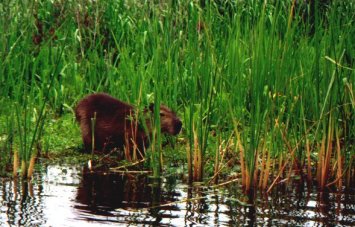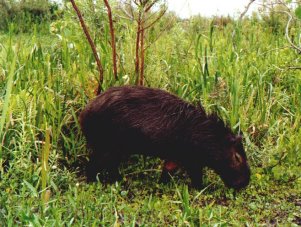Chile - Argentina 2000: Los Esteros Del Ibera
| The marshy-land
areas and the lagoons with their rich ecosystems undoubtedly represent
one of Argentina's most important biological areas. This huge system
of wetlands, together with a high diversity of animal and plant species,
makes up a substantial part of Corrientes' natural assets. Therefore,
in order to preserve its natural resources, the internationally known
beauty of its landscapes and the biodiversity of its ecosystems, the
Government of the Province of Corrientes created the Ibera Reserve
by law, on April 15, 1983.
Old river beds or the Parana's abandoned ones currently make up
the basis of this independent and complex net of moist soil, which
comprises swamplands, marshy lands, lagoons, sloughs and pluvial-origin
streams. |
aaa | 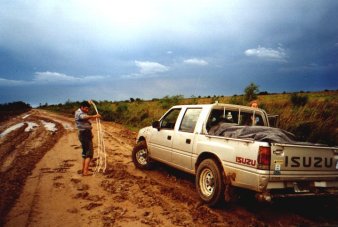 |
|
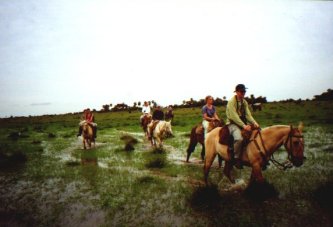 |
|||
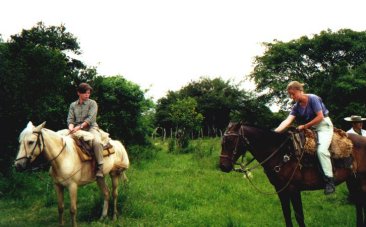 |
|||
| A mammal with water habits, the capybara
(carpincho) never goes too far away from the water, from which
it depends on for bathing, drinking, taking shelter and feeding on
water plants. Like every rodent, the capybara has continuous-growth
incisors. Mainly herbivorous, it grazes mid-afternoon till late at
night. It is an exclusively American species. The muzzle, ears, and eyes are aligned on the upper part of the head, allowing it to swim with almost all the body under the water. The membrane between its toes is a clear sign of its adaptation to the water environment. It is not excessively active. It is usually seen lying on the shore, sometimes half way into the water to regulate its body temperature. The species' gregariousness is shown in the frequent physical contact among the members of the herd. Adults reach 120cm and 50kg. It shares the habitat with some insectivorous birds. It flocks in sedentary herds. The young (usually 1 to 7) are born after 122-153 days, and show an advanced development state. Since the first few days they are able to nurse and follow their mother. The capybara's fur is affected by the contact with clayey mud, and apparently renovated periodically. Adults are brown and ruddy. The male is darker on the belly and the rump. The ears are blackish, not very developed, rounded and soft and they have a fold which allows the shutdown of the ear channel when the capybara goes underwater. Courting and copulation take place underwater. Occasionally, some lonely individuals may appear, generally males, but they are commonly seen resting, grazing or swimming in groups. |
|||
| One of the 62 lagoons that
make up the big ecosystem is the Iberá Lagoon, in which boarders
the town called Carlos Pellegrini, a small town of only 600
inhabitants. Inside this colony is the hostelry Ñanderetá
( that means "our land"). An open window to nature, giving
the visitor an exotic environment with majestic views and unforgettable
experiences.
Ñanderetá
Inn gives its visitors very comfortable rooms and efficient
personalized attention to give them a more comfortable stay. Established
in a wood and stone building in the middle of the woods surrounded
by pines and a great variety of plants and flowers. Double and triple
rooms with private bathrooms, living rooms, game rooms, restaurants,
bar, a library, a video library with specialized graphic material,
view terrace, cellular phones, dock, boats, our own horses and excursions
with special tracks are some of the services offered. The owner,
Cielo, born in the city of Mercedes and belongs to a traditional
family in Corrientes, along with her husband and children, they
all build a familiar environment which makes the staying a lot more
cozy. |
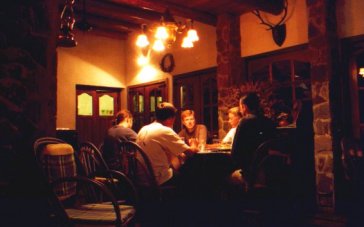 |
||
| The eyes, ears and nostrils of the
Black Caiman are located in the upper part of the head, allowing
it to swim almost completely concealed under water, making it difficult
for its preys and predators to spot it. Its trail propels it along,
as it keeps its legs folded close to the body. On the land, it crawls
with its belly almost sticking to the ground. However, it can get
on all fours and reach a notable speed. Its large, fleshy tongue is
stuck to the floor of its mouth cavity. They are quite inactive during daytime, spending hours sunbathing to regulate their body temperature. After mating in the water, the male shows no interest in the process of gestation. Nest building is an exclusive task of females which, using their legs, body and tail, accumulate - depending on the water conditions - shore plant remnants, making a 1.5 diameter spot with a hole in the center. It lays around 50-60 oval 6-cm eggs, whose shell is hard, whitish and wrinkled. It orders them in layers and then covers them with earth and branches. Thus they are hidden and protected. The mother does not take part in the hatching process, which is January to March. Embryos grow thanks to the summer heat and the decomposition of the plants making up the nest. The female just watches, hatching with her stare. Around two months later, the eggs are hatched. As the eggshell is very thick, newborns have a special tooth to break it with. This tooth is located in the tip of the snout, and it falls off a few days later. As soon as they are born, the offspring utter hoarse growls. The mother answers this call, meeting the 5cm long cubs, with large bulging eyes, a short snout, and soft, light green skin with black spots and bars. During their first few days of life they eat larvae and insects from the plants making up their nests. Then the mother leads them to the water, and will continue to look after them for a year, time during which they will stay close to the nest. They grow slowly. They take almost two years to reach a length of 30 cm, and several more to reach maturity. They then may reach a length of 2m and a weight of 55kg. |
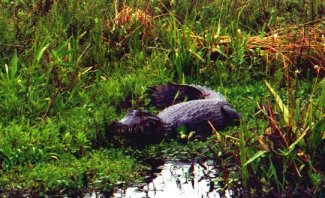 |
||
|
Intro Torres Del Paine NP Glaciares NP Peninsula Valdez Iguazu NP Los Esteros Del Ibera Buenos Aires The Birding Pages |
